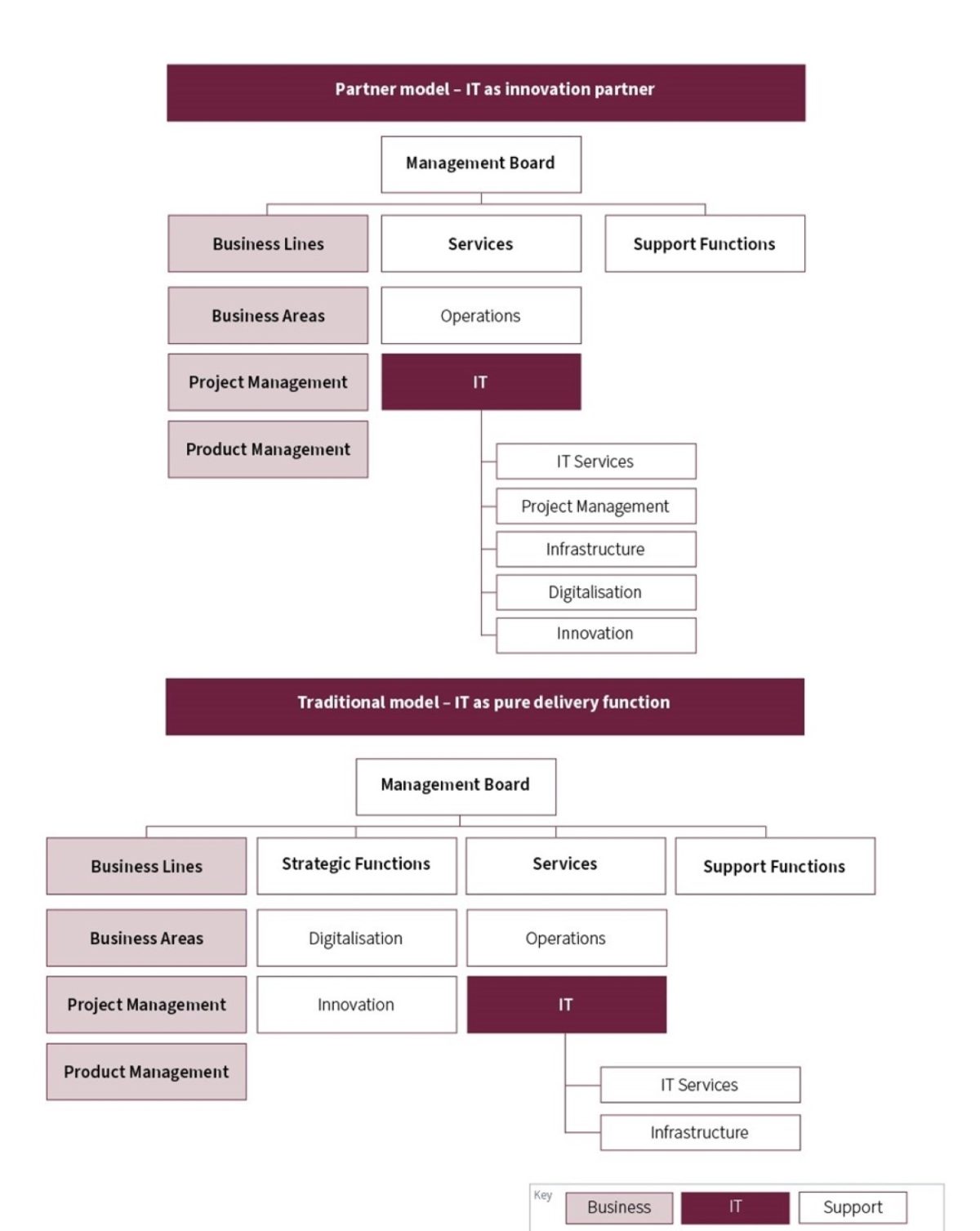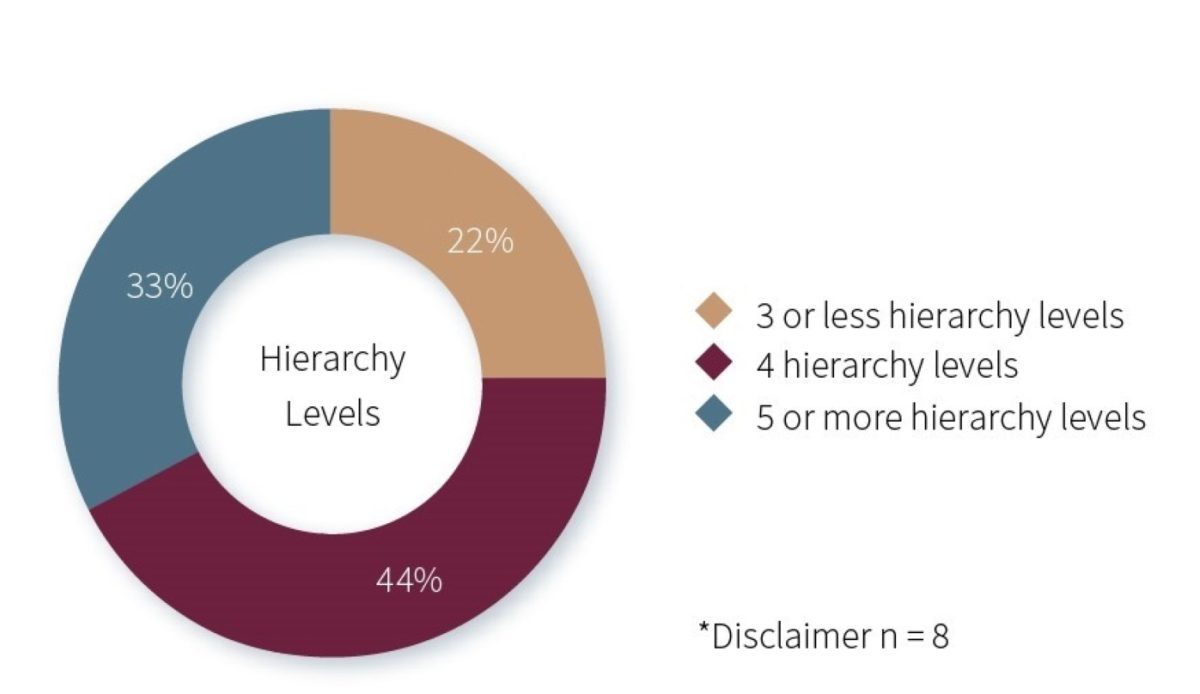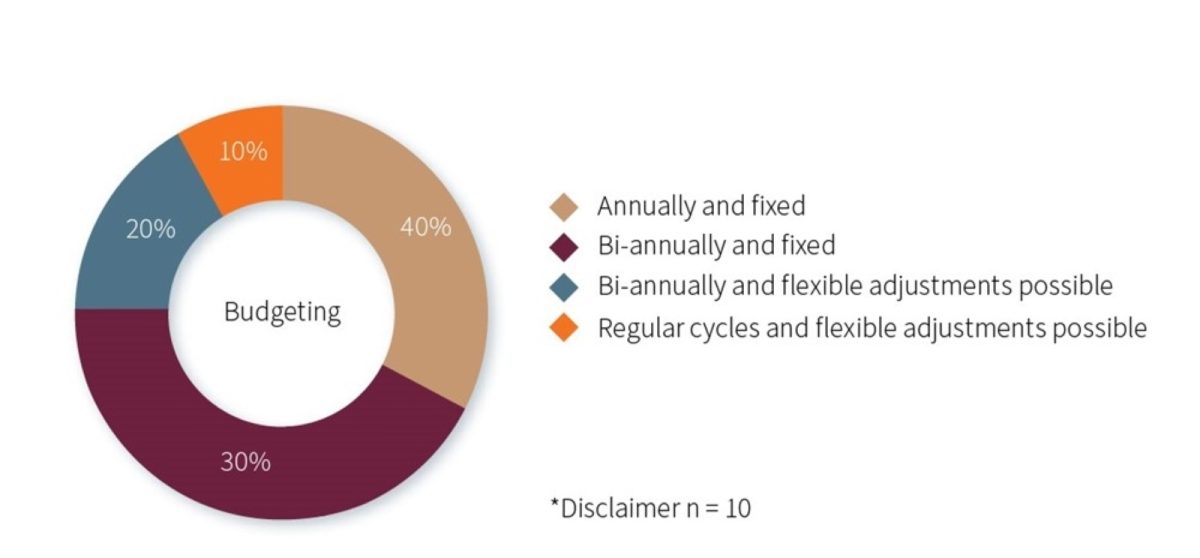This article is the second in a series of five under the main title “How Ready Are Swiss Banks to Become Organisations of the Future?”. In this chapter, we deep dive into the organisational structures and processes of the investigated banks.
The two models of organisational structure
In the first chapter, we looked at how the investigated banks have organised both business and IT departments, and how this is linked to collaboration.
The vast majority of banks interviewed structure their business departments along client segments and regions. Only two banks are structured along the client journey and a few along the offered client products.
As technology plays a more and more important role in banks’ success, banks need to ramp up their tech capabilities and reposition the role of IT within the entire organisation. This has led to the organisational position of the IT department becoming a crucial element of the entire structure, with far-reaching ramifications for the bank as a whole and its potential for success.
Based on the study's insights, we recommend that banks structure IT and the business side in an aligned way, as a collaboration between the two departments works significantly better that way. But this conclusion is not as straightforward as it seems, and the road to its implementation is a difficult one for many banks.
In the real world, we observed two primary models of organisational structure concerning IT, in which it takes a different role within the organisation:
- Partner model
- Traditional model
In the partner model, IT works closely with the business side. They actively engage in developing new ideas, driving projects, and eventually becoming an innovation partner to the business. In the traditional model, IT is a delivery function that acts as the recipient of decisions and requirements coming from the business. All initiatives related to digitalisation, innovation, and strategic technology are driven mainly from the business side.

Most banks follow the traditional model or are located somewhere in between, whereby banks display characteristics of both the partner and traditional model.

Banks following a partner model report being more flexible, and, hence, quicker in adapting to new circumstances, such as changed customer needs, new market trends or regulatory requirements. Furthermore, their organisational setup facilitates cross functional collaboration and communication.
However, a traditional model might also work very well for a bank, as the roles and responsibilities of the different departments and functions are clearly defined. The setup with business setting priorities and driving strategic initiatives, on the one hand, and IT as receiving end, on the other hand, might be very efficient.
The limitations mentioned by banks operating in a traditional model are:
- More rigid silos
- Limited mutual understanding between business and IT, and, hence, more complicated communication
- Inefficiencies with IT being involved late in the process (as technical aspects or architectural considerations are not included in decision making, dependencies are not detected at the beginning)
- Missed opportunities in innovation projects without having IT onboard
Furthermore, we observed that banks operating in the partner model have flatter hierarchies than banks with a traditional model.

Key takeaway
The organisational structure directly influences (i.e., facilitates or hinders) the collaboration across teams and functions. An aligned organisational structure of the business and IT facilitates focused delivery.
Banks with a partner model organisation encourage a mindset shift within the IT department from a pure service orientation (short-term focus) towards a more future-oriented client value-driven orientation (long-term focus).
Collaboration between business and IT
Even after aligning the organisational structures of IT and the business side of a bank, collaboration may not automatically improve, especially if the old patterns of thinking and behaviour persist in the new setup. It is just as important to break up the silos in the minds of the employees, as in the org chart.
The insights gained in our study have allowed us to formulate several concrete measures that can be taken to unlock the potential of an aligned organisational structure:
- Create and communicate a shared vision
- Facilitate direct communication lines
- Change project team setup (e.g., combine tech and business analysis, combine IT and business project leads in strategically relevant projects)
- Change governance – early involvement of all parties and stakeholders, ideally already in the ideation phase
- Focus on talent management – finding talents with both technical and business backgrounds is difficult. Invest in employer branding and positioning at universities, engage with dedicated headhunters, offer competitive salaries, offer flexibilities, etc.
- Allow rotations – people moving from IT to business for a period of time and vice versa to get a better understanding
- Introduce shadowing – people from business working for one week next to someone from IT and vice versa to see what the actual doing looks like
- Invest in education – offer internal training and external courses on selected business and IT topics
- Organise joint events to foster a one team spirit
Our flat hierarchy, the cross-functional project organisation, and the distinctive solution-oriented team spirit enable a lean and effective collaboration between IT and business.
Key takeaway
Apart from aligning organisational structures, the collaboration between the IT and business side of a bank can be enhanced through various measures, such as changing governance, facilitating communication lines, job rotations, and shadowing between IT and business.
Decision-making process
Organisational restructuring can happen for many different reasons. For example, due to strategic reorientation, increased focus on client centricity, enhanced efficiency, or optimised management span.
Independent of the underlying reason, we have observed that many banks changed their organisational structure in the past without adjusting the underlying processes, in particular the decision-making process. This means that teams have been re-organised but responsibilities and accountabilities have often remained as they were. In many cases, the impacted teams have no stake in the decision-making and company outcomes. This has often been mentioned as a limiting factor of the organisation.
The traditional and the partner model differ greatly in the way decisions are made, with deep consequences up and down the line. In the traditional model, decisions typically come from the top and are distributed down to the functions that ultimately execute them. In the partner model, by contrast, responsibilities and accountabilities are distributed more to teams.
The figure below shows the organisational models in the study. A certain clustering in the middle can be read as a lack of commitment one way or the other, or as a snapshot of dynamic change over time.

Distributing responsibilities and accountabilities means empowering teams and individuals. First, management has to get used to not being involved in all matters. Second, people have to get used to what it means to be responsible and accountable.
Many banks – certainly those that have been most successful in implementing a partner model – have trained their people accordingly and closely coached them. Simply declaring oneself to be organised according to the partner model is not by itself a way to achieve success.
ORGANISATIONAL AGILITY
Read the full white paper and get a complete view of how Swiss banks score in all aspects of organisational agility.
Prioritisation and budgeting
A bank may have adjusted its organisational structure and changed decision-making – does this mean, the organisation is now more flexible, more efficient, and more effective? Not necessarily.
The investigated banks prioritise their change project portfolio and assign budget once, or, in some cases, twice per year. In almost all cases, top management is exclusively involved in this process.

A lot can happen within one year. Customers' needs change, challengers emerge in the market, and new technologies come to the scene. The ability to quickly react amid rapid market changes can make all the difference in a project’s chances of success.
All of the investigated banks have mentioned a disconnect between rapid changes in project delivery and budgeting as a hurdle. To attain this flexibility, banks should change their budgeting process, moving towards continuous cycles as opposed to once per year.
We are moving away from annual top-down budget allocations requiring detailed requests and delivery plans. We have started to allocate budgets to overarching themes or platforms to be able to have more flexibility in delivery.
Budgets should also be assigned to larger topic areas and undertakings, not small projects. And teams should be given the power to decide how to invest in different projects. This change is a big one for top management, as they will be less involved and will not know on a granular level what they will receive for the assigned budget.
Another success factor mentioned by the banks is involving relevant stakeholders from IT and business (not only top management) early in the process of determining priorities and budgets and giving them the flexibility to make changes when necessary.
The budget has lways been one of the main tools for setting priorities, controlling outcomes, and steering strategy. To relinquish even a part of this toolset is a big task for top management. Nevertheless, we consider it a prerequisite for success in the current context.
Conclusion
Most banks in the study follow the traditional organisational model or fall somewhere between the traditional and partner model. Silo thinking is one of the greatest challenges in the traditional model, and the siloed structure can hinder collaboration across teams and functions.
Banks with a partner model tend to align IT and the business side – in terms of team structure (e.g., the structure according to client journeys or product offerings), decision-making, and involvement in priorities and budgeting. This alignment encourages a mindset shift, where IT becomes a true partner to the business.
Looking at the investigated banks, we believe that by validating and adjusting organisational structures, as well as underlying processes, they can make their organisations even more flexible, efficient, and effective.
Leave your contact details here, and we will be happy to forward you the full whitepaper.

Chapter 1: Swiss Banks: Future Leaders or Complex Constructs Stuck in the Past?
Organisational agility and its determining components are the central factors to success in the current environment of rapid change on multiple fronts, including society, technology and markets.
Read Chapter 1

Chapter 3: Adopt Agile Ways of Working to Improve Customer Focus and Time-To-Market.
One aspect of organisational agility is the organisations’ way of working and delivering. The benefits of agile ways of working are undisputed: Higher customer focus, increased time-to-market, enhanced product quality and much more.
Read Chapter 3

Chapter 4: Focus on Dynamic Capability Management.
The way banks execute projects, and the capabilities required to do so, have changed significantly over the last decade. To stay organisationally flexible and agile as well as close to market developments, banks need to have what we call “dynamic tech capabilities.”
Read Chapter 4

Chapter 5: How to Become a Future Leader. As organisational agility has become a central concept in the industry, it has taken on many nuanced meanings across organisations. But for those who take it seriously, the core remains constant: a way of adapting to be close to clients’ need and meet the challenges of today's market place.
Read Chapter 5


